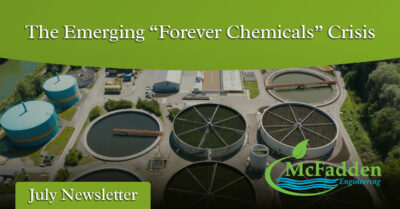Master Planning Basics
November 30, 2021

By: Brad Newton
Effective master planning water and wastewater systems can contribute to the success of your business. Master planning enables utilities to develop a strategy for funding infrastructure as well as determining the efficient timelines for the implementation of facilities and individual utility components.
Many utilities have the daunting task of prioritizing projects and allocating funds to maintain service areas. To do this, it is important to assess the existing conditions of the current infrastructure and identify critical areas that need to be addressed. Master planning answers 3 major questions for the utility through technical, operational, and financial evaluations –
- What projects do I need to do?
- When do I need to do these projects?
- How am I going to pay for these projects?
For a utility, master planning involves a number of steps with the ultimate goal of developing a plan to achieve long term sustainability. The following provides the basic outline of the steps in developing a master plan for utility:
Condition of the Infrastructure
The first step in the process is inventory and evaluation of the existing assets the utility has at its disposal. It is imperative to evaluate the overall condition of all infrastructure, identify equipment that needs repair or replacement, and determine areas of the system that are currently in good condition.
Capacity Review
By reviewing the capacity, it can be determined if the current facilities can meet the current as well as the future needs of the service area. This allows the utility to identify potential expansion areas, plan for the expansion and appropriately size the new equipment for the expected growth. This can easily be accomplished through the development of a hydraulic model of the water or wastewater network.
Water Quality Evaluation
Regulatory requirements drive the types of treatment facilities that are required or needed. Water quality evaluations are a great tool to determine if the current treatment equipment is adequately meeting current regulatory requirements. Customer expectations are also a consideration and should be addressed during this portion of the evaluation.
Repairs, Rehabilitation, and Replacement
By identifying problem areas and prioritizing repairs, costly emergency repairs and service interruptions can be minimized. This evaluation will also allow the utility to schedule and dedicate resources to specific areas that need more attention.
Operation and Maintenance
By reviewing the operation and maintenance records of a utility, opportunities for system upgrades, optimization, and increased efficiency can be identified.
Immediate Goals
When the information is collected and analyzed, a priority list can be established so that the utility can quickly address the most pressing issues.
Long-Term Goals
This requires the development of a plan that acts as the “roadmap” to meet future needs and provide a vision for expansion. By projecting future growth, these long terms goals account for the vision the leadership has for the utility and charts a course for how to achieve this vision.
Funding
Identification of avenues to fund these projects is one of the most important aspects of the master planning process. It allows the utility to identify revenue sources that will fund capital projects, as well as operation and maintenance needs. This evaluation is also used to determine how to generate affordable revenue streams for the utility through its fee structure.
Ultimately, the goal of the master planning process is to develop a plan that the utility can use to better meet the current needs of its customer base while looking to address the future needs of the system through infrastructure upgrades, system expansion, and new facilities.
McFadden Engineering develops master plans that allow our clients to have a “roadmap” for future success and assist with the implementation of the plan. Let us partner will you on your future project.
